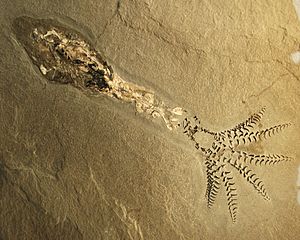Belemnite facts for kids
Quick facts for kids Belemnoids |
|
|---|---|
 |
|
| Well preserved Phragmoteuthis, with arm hooks and outline of mantle | |
| Scientific classification | |
| Kingdom: | |
| Phylum: | |
| Class: | |
| Subclass: | |
| Superorder: |
Belemnoidea
|
| Orders | |
|
Aulacocerida |
|
Belemnites (also called belemnoids) were an extinct group of sea creatures. They were a type of cephalopod, which means they are related to modern squid and cuttlefish.
Like squids, belemnites had an ink sac. But unlike squids, they had ten arms that were all about the same length. They did not have the long tentacles that many modern squids have.
Belemnites belong to a larger group called the Belemnoidea. This group includes four different orders of belemnites.
Contents
Where Belemnites Lived
Belemnites first appeared a very long time ago. They evolved from an older group of cephalopods called nautiloids. The first clear belemnite fossils can be found in rocks from the Mississippian Period. This was about 359 to 318 million years ago.
Belemnites were very common during the Jurassic and Cretaceous periods. These are the times when dinosaurs lived! Their fossils are found in many marine rocks from the Mesozoic Era. They are often found with their cousins, the ammonites. Both belemnites and ammonites died out at the end of the Cretaceous period. This was about 66 million years ago, at the same time the dinosaurs disappeared.
How Belemnites Lived
Belemnites were active hunters, just like many modern squids. They were carnivores, meaning they ate other animals. They would catch small fish and other sea creatures. They used the hooks on their arms to grab their prey. Then, they would eat their food using their strong, beak-like jaws.
Belemnites were also food for other animals. Large marine reptiles, like Ichthyosaurs, often ate them. Scientists know this because they have found belemnite arm hooks inside the fossilized stomachs of Ichthyosaurs!
Belemnites usually swam in oceans that were not too far from the shore. They also lived in slightly deeper waters.
Ancient Ink and Other Body Parts
Fossils that show the soft parts of belemnites tell us a lot. Like many modern cephalopods, they had an ink sac, hard beaks, tail fins, and large eyes. Some very well-preserved fossils even show muscle fibers in their mantle. This suggests that belemnites were powerful swimmers, much like modern squids.
In 1826, a famous fossil hunter named Mary Anning made an amazing discovery. She found what looked like a chamber filled with dried ink inside a belemnite fossil. She showed it to her friend Elizabeth Philpot. Elizabeth was able to mix the dried ink with water. She then used this ancient ink to draw some of her own Ichthyosaur fossils! Other artists in the area soon started doing the same thing.
Mary Anning noticed how similar these fossilized ink chambers were to the ink sacs of modern squid and cuttlefish. She had studied these modern animals to understand ancient cephalopods better. This led a scientist named William Buckland to suggest something important. He believed that Jurassic belemnites used ink for defense, just like many modern cephalopods do today. They would release a cloud of ink to confuse predators and escape.
Images for kids
-
Fossil belemnite. This shows the rostrum and phragmocone. You can also see the inner structure of the rostrum made of calcite fibers.
-
The Jurassic Youngibelus reconstructed with hectocotyli
-
Cephalopod embryonic shells. A) Ammonoidea (B) Sepiida (C) Belemnoidea (D) Spirulida (E) Orthocerida (F) Nautilida (G) Oncocerida (H) Pseudorthocerida (I) Oegopsina (J) Bactritida. IC indicates the initial chamber.
-
MRI of a deformed Late Cretaceous Gonioteuthis guard
-
Opalized Peratobelus guard from the Early Cretaceous
-
Belemnites with Early Jurassic Dactylioceras ammonites
See also
 In Spanish: Belemnitida para niños
In Spanish: Belemnitida para niños











